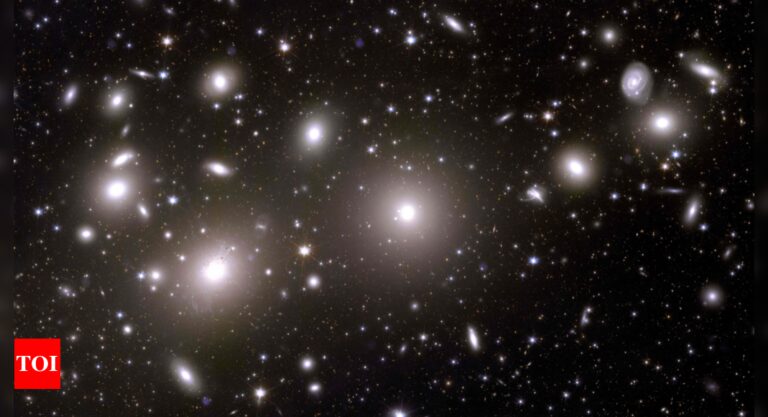
[ad_1]
Euclid, tasked with unveiling the dark Universe’s secrets, has encountered a hurdle: microscopic layers of water ice are clouding its view. This challenge, stemming from the spacecraft’s exposure to the harsh cold of space, demands unprecedented precision for its mission’s success.
Mirror, mirror, chilled in space
Efforts are now underway across Europe to implement a novel de-icing procedure designed to restore Euclid’s clarity and maintain its optical systems for the duration of its orbital life.Similar to how drivers remove ice from their car windshields in winter, the European Space Agency’s (ESA) scientists are embarking on a unique mission to “de-ice” the Euclid observatory’s telescope mirrors, situated over a million miles from Earth. These ice layers, though only as thick as a strand of DNA, have led to “a small but progressive decrease” in starlight detection, as noted by ESA in a recent announcement.
Addressing the fog: Euclid’s diminishing sight
As Euclid embarked on its celestial journey, experts noted a slight yet progressive dimming in the stars’ light captured by the visible instrument (VIS). Mischa Schirmer, a pivotal figure behind the new de-icing strategy, observed, “Some stars in the Universe vary in their luminosity, but the majority are stable for many millions of years. So, when our instruments detected a faint, gradual decline in photons coming in, we knew it wasn’t them – it was us.” This realization sparked a meticulous investigation into the unwanted accumulation of water, leading to the development of a targeted response.
The mission’s current phase involves carefully heating areas of the spacecraft deemed low-risk, where water release poses minimal risk to other instruments. “De-icing should restore and preserve Euclid’s ability to collect light from these ancient galaxies, but it’s the first time we’re doing this procedure,” admitted Euclid scientist Reiko Nakajima, underlining the pioneering nature of this operation.
Crafting the countermeasure: A strategic approach to de-icing
The collaborative efforts spearheaded by Euclid’s dedicated teams across Europe, including insights from the ESA’s ESTEC and coordination by Ralf Kohley, culminate in a sophisticated plan to combat the ice. The strategy involves cautious heating of specific spacecraft components to avoid compromising Euclid’s delicate optical alignment. “Switching on the heaters in the payload module therefore needs to be done with extreme care,” explains Andreas Rudolph, highlighting the mission’s unique thermal-optical stability demands.
Future-proofing Euclid: The long-term de-icing strategy
Acknowledging that water will continue to seep into Euclid’s systems, the mission teams have devised a sustainable approach to periodically remove ice without disrupting the mission’s critical timeline. Reiko Nakajima emphasizes the importance of this procedure for Euclid’s primary mission: to map the Universe and probe the mysteries of gravitational lensing. The teams stand ready to pinpoint and address the ice’s location, aiming to ensure Euclid’s enduring capacity to observe distant galaxies and contribute to our cosmic understanding.
Mirror, mirror, chilled in space
Efforts are now underway across Europe to implement a novel de-icing procedure designed to restore Euclid’s clarity and maintain its optical systems for the duration of its orbital life.Similar to how drivers remove ice from their car windshields in winter, the European Space Agency’s (ESA) scientists are embarking on a unique mission to “de-ice” the Euclid observatory’s telescope mirrors, situated over a million miles from Earth. These ice layers, though only as thick as a strand of DNA, have led to “a small but progressive decrease” in starlight detection, as noted by ESA in a recent announcement.
Addressing the fog: Euclid’s diminishing sight
As Euclid embarked on its celestial journey, experts noted a slight yet progressive dimming in the stars’ light captured by the visible instrument (VIS). Mischa Schirmer, a pivotal figure behind the new de-icing strategy, observed, “Some stars in the Universe vary in their luminosity, but the majority are stable for many millions of years. So, when our instruments detected a faint, gradual decline in photons coming in, we knew it wasn’t them – it was us.” This realization sparked a meticulous investigation into the unwanted accumulation of water, leading to the development of a targeted response.
The mission’s current phase involves carefully heating areas of the spacecraft deemed low-risk, where water release poses minimal risk to other instruments. “De-icing should restore and preserve Euclid’s ability to collect light from these ancient galaxies, but it’s the first time we’re doing this procedure,” admitted Euclid scientist Reiko Nakajima, underlining the pioneering nature of this operation.
Crafting the countermeasure: A strategic approach to de-icing
The collaborative efforts spearheaded by Euclid’s dedicated teams across Europe, including insights from the ESA’s ESTEC and coordination by Ralf Kohley, culminate in a sophisticated plan to combat the ice. The strategy involves cautious heating of specific spacecraft components to avoid compromising Euclid’s delicate optical alignment. “Switching on the heaters in the payload module therefore needs to be done with extreme care,” explains Andreas Rudolph, highlighting the mission’s unique thermal-optical stability demands.
Future-proofing Euclid: The long-term de-icing strategy
Acknowledging that water will continue to seep into Euclid’s systems, the mission teams have devised a sustainable approach to periodically remove ice without disrupting the mission’s critical timeline. Reiko Nakajima emphasizes the importance of this procedure for Euclid’s primary mission: to map the Universe and probe the mysteries of gravitational lensing. The teams stand ready to pinpoint and address the ice’s location, aiming to ensure Euclid’s enduring capacity to observe distant galaxies and contribute to our cosmic understanding.
[ad_2]
